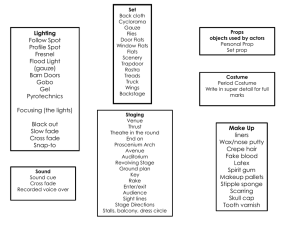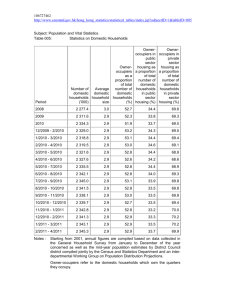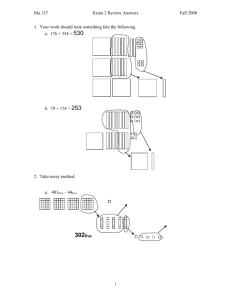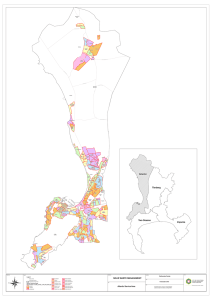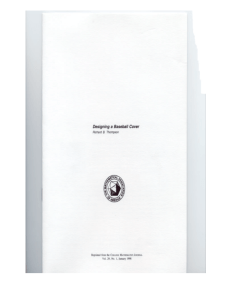NIC1 Narrow-band Earth Flats
advertisement
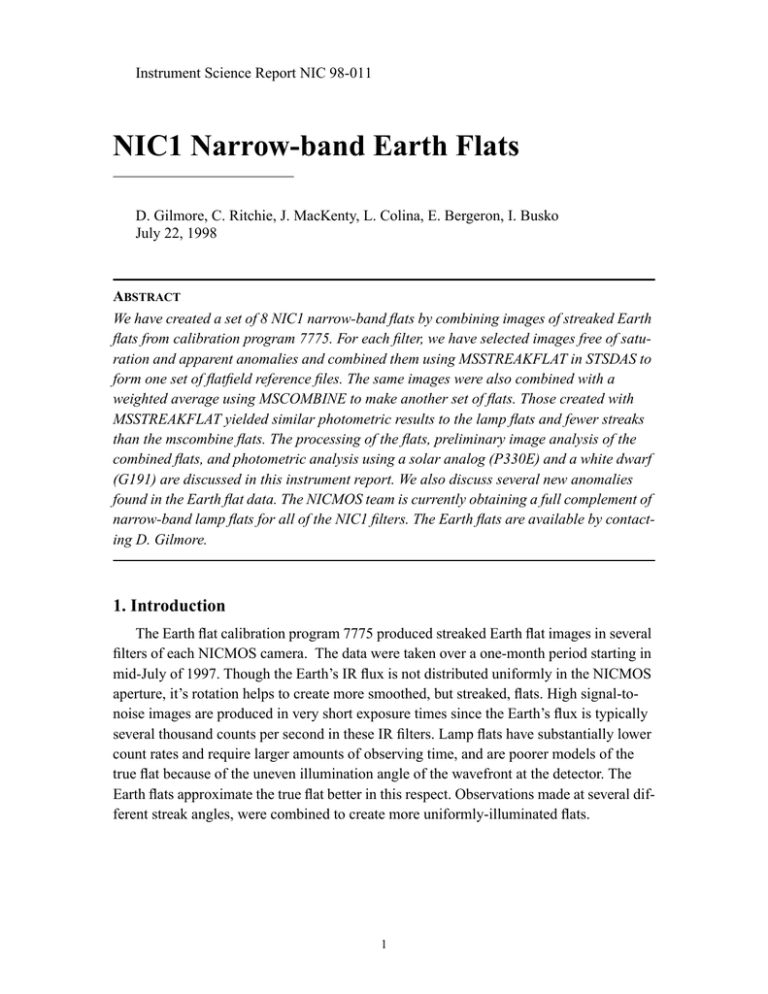
Instrument Science Report NIC 98-011
NIC1 Narrow-band Earth Flats
D. Gilmore, C. Ritchie, J. MacKenty, L. Colina, E. Bergeron, I. Busko
July 22, 1998
ABSTRACT
We have created a set of 8 NIC1 narrow-band flats by combining images of streaked Earth
flats from calibration program 7775. For each filter, we have selected images free of saturation and apparent anomalies and combined them using MSSTREAKFLAT in STSDAS to
form one set of flatfield reference files. The same images were also combined with a
weighted average using MSCOMBINE to make another set of flats. Those created with
MSSTREAKFLAT yielded similar photometric results to the lamp flats and fewer streaks
than the mscombine flats. The processing of the flats, preliminary image analysis of the
combined flats, and photometric analysis using a solar analog (P330E) and a white dwarf
(G191) are discussed in this instrument report. We also discuss several new anomalies
found in the Earth flat data. The NICMOS team is currently obtaining a full complement of
narrow-band lamp flats for all of the NIC1 filters. The Earth flats are available by contacting D. Gilmore.
1. Introduction
The Earth flat calibration program 7775 produced streaked Earth flat images in several
filters of each NICMOS camera. The data were taken over a one-month period starting in
mid-July of 1997. Though the Earth’s IR flux is not distributed uniformly in the NICMOS
aperture, it’s rotation helps to create more smoothed, but streaked, flats. High signal-tonoise images are produced in very short exposure times since the Earth’s flux is typically
several thousand counts per second in these IR filters. Lamp flats have substantially lower
count rates and require larger amounts of observing time, and are poorer models of the
true flat because of the uneven illumination angle of the wavefront at the detector. The
Earth flats approximate the true flat better in this respect. Observations made at several different streak angles, were combined to create more uniformly-illuminated flats.
1
Saturation:
Earth’s IR flux is very variable (we noted count rates varying by almost 2 orders of
magnitude during a given multiaccum, and about 3 orders of magnitude between images
taken over a month in the same filter). Saturation in the medium and wide bands made it
impossible to produce good Earth flats from these data. We have attempted to analyze and
process only the narrow-band flats (Table 1). In addition, a few flats were rejected because
of very low count rates and a few because of large amplitude streaks.
Some medium and wide-band images were unusable because of saturation in the first
or even zeroeth read. Only the narrow-band filter images had enough good reads free of
saturation to warrant making flatfield referernce files from them. This ISR will address the
NIC1 narrow-band frames alone, of which there are 8 observed filters, all using exposure
time sequence STEP16. The 5 narrow-bands from NIC2 will be discussed in a later ISR.
All but a few of the NIC3 flats were affected by saturation because of the larger pixel size
(NIC3 pixels are a factor of 25 larger in area than NIC1 pixels), even with the faster sampling rates used (SCAMRR).
Calibration program 7775 consisted of 8 NIC1 narrow-band filters (Table 1) which we
will discuss in this report. Other filters observed in program 7775 include:
•
3 NIC1 Medium and Wide band filters { F110M, F110W, F160W }
•
8 NIC2 filters { F187N, F190N, F212N, F215N, F216N, F110W, F160W, F222M }
•
6 NIC3 filters { F110W, F160W, F164N, F166N, F187N, F190N }
Comparisons with in-flight lamp flats from proposal 7689 were made where possible,
and with in-flight and ground lamp flats that were produced from earlier calibration programs. The comparison files are listed in Table 1.
Table 1. .Prop 7775 NIC1 Narrow-Band Earth Flats
FILTER
Comparison
Ground Flat
Comparison
Inflight Flat
Comparison
prop7689 flat
Final
Number
of Images
Average
Nread
Mean S/N
Streak
Angles
F095N
ha911520n
ha91153sn
-------
11
5.8
91
5
F097N
ha911521n
ha91153tn
i350934cn
8
5.9
82
4
F108N
ha911522n
ha911540n
-------
6
6.7
89
4
F113N
ha911525n
-------
-------
5
6.0
76
3
F164N
ha911529n
ha911541n
i350934dn
3
5.7
87
2
F166N
ha91152bn
-------
i350934en
4
6.8
98
4
F187N
ha91152dn
-------
i350934fn
9
10.0
34
5
F190N
ha91152en
-------
i350934gn
10
9.1
45
6
2
"Super-shading":
This is an anomaly which predominantly occurs in the first several readouts of an individual multiaccum dataset (IMA). IMAs with super-shading have a ramp in intensity in
the slow readout direction which repeats midway through the image. In NIC1 images
super-shading is manifested as a ramp in the y direction. An example is shown in Figure 1.
The cause is not known at this time, but may be triggered by exposure of the detectors to a
bright event just prior to observation of the flats (perhaps even by previous Earth flats).
The effect has only been seen in the Earth flats, and not in any other science or calibration
data at this time. In the Earth flats super-shading occurs in about 40% of the NIC1 narrow-band multiaccum datasets. It has been seen in all observed filters and in all 3
cameras.
In constructing the flatfield reference files, we selected those free of super-shading in
the following way: The average column was plotted for each final IMA unaffected by saturation. Those IMAs with a 2% drop or less across rows 128-129 (Figure 1) in the
average column were accepted. In the case of F187N however we relaxed the cutoff to
5%, since the only 3 images unaffected by saturation had larger drops. The numbers of
images that were combined to make each filter flat are listed in Table 1. Column 5 of
Table 1 shows the final numbers of unsaturated images with enough flux that passed the
super-shading criterion out of 12 to 14 images observed for each filter. Column 6 in the
table lists the average number of reads from images in each filter that went into making the
flat in that filter. Assuming Poissonian statistics, the signal-to-noise of each image that is
coadded to make a given reference flat can be calculated as the square root of the total
number of counts from the final IMA read. The mean S/N for the final flat is listed in column 7 of Table 1. Finally, column 8 shows the number of different streak angles that went
into each combined flat.
3
Figure 1: NIC1 Super-Shading.
F108N NIC1
NIC1 F108N
6000
Earth/Lamp
5000
4000
3000
2000
1000
0
0
50
100
150
200
250
Row
The top image shows one readout of a NIC1 flat field in F108N affected by “super-shading”. The bottom
image is the same flat after dividing by a recent in-flight lamp flat in the same filter. The plot to the right
shows the average column of this flattened flat.
2. Image Processing and Flatfield Reference File Construction
CALNICA processing:
CALNICA was partially executed on the Earth flats to produce individual multiaccum
(IMA) images in count rates. Dark subtraction using the best available model darks was
included in this step. The last good readout of each multiaccum prior to saturation was
then selected for further processing.
Most of the pixels of the data quality file are flagged as cosmic rays in the current version of CALNICA because of fluctuating count rate during the multiaccum, rendering the
CAL files produced by CALNICB unusable. The CR data quality bit was therefore corrected before combining images to create the final flats. To accomplish this, we flattened
all of the Earth flats using the best available lamp flat and marked as cosmic rays those
pixels which exceeded a 2.5 sigma threshold from the mean value.
4
Combining flats:
The final IMAs selected to be free of shading and saturation were combined using two
different methods:
1. MSCOMBINE. The IMAs were normalized to the same mean count rate in the
region [*,35:256]. This is the standard region used when normalizing reference
flats. An average of input images weighted by the square root of their total counts
was then computed using MSCOMBINE. Sigma clipping was performed during
the average to further reduce real CRs (high and low pixels were clipped at 2.5
sigma). A few CRs survived this process, however.
2. MSSTREAKFLAT. Msstreakflat divides each Earth flat image by the mean image
and normalizes the resultant images by their mean value. A median flat is then
computed. The ratio of the Earth flats to the median flat is used to estimate the
streak pattern. The Earth flats are then divided by the streak flats smoothed along
the streak direction to form a new set of working Earth flats. The streak angle is
computed from support file header (spt) values giving the direction of the Earth’s
motion relative to the telescope coordinate frame. The entire process is repeated
using the newly constructed flats. After several iterations using successively narrower boxwidths during smoothing to remove streaks at a range of spatial frequencies, a final median flat is produced.
Regardless of the method used to combine flats, the final combined images were subsequently normalized to 1 in the region [1:256,35:256] and inverted to create the final
flats.
5
3. Analysis
Comparisons with previous flats:
Gross flat-field differences are seen in ratios of Earth flats with ground flats (Figure 2).
The differences between mounting cup temperatures of flats observed on the ground
(T=58 K) and on orbit (T=61.3 K) account for the largest differences seen. The lowest
intensity features seen in Figure 2 are about 20% below the mean, and the brightest features are about 8 percent above it. A similar stretch is applied to all images in Figure 2 for
direct comparison with one another.
Figure 2: Comparison with Ground Flats.
Significant differences are seen in ratios of Earth flats to ground flats.
F095N
F108N
F164N
F187N
F097N
F113N
F166N
F190N
The temperature differences between in-flight flats is less significant, so smaller
effects become apparent in ratios between Earth and in-flight lamp flats.
We divided flats made with MSSTREAKFLAT by flats made using MSCOMBINE.
These are shown in Figure 3 below. “Streaks”, “fringes” and global differences are seen in
flats produced by the two methods. They are described below.
Streaks:
Streaks at a level of a few percent are apparent in Figure 3 in the ratios of filters
F113N, F164N and F166N, and in Figure 4 at F166N. Streaks occur when the number of
different streak angles is small. The hope was to schedule observations in such a way that
6
a large number of streak angles were sampled so that the final average flat would be as free
from streaks as possible. Flats observed in consecutive orbits, for example, have similar
telescope roll angle, and similar streak angles. The last column of Table 1 lists the number
of different streak angles obtained for each of the filters. Though proposal 7775 was
planned to observe many flats over the period of a month, files unaffected by saturation
and super-shading have a high probability of having been observed closely spaced in time,
and therefor at similar roll angle.
Figure 3: Comparison of Flats Made With MSSTREAKFLAT and MSCOMBINE.
Fringes and streaks are apparent in these ratios of MSSTREAKFLAT flats to MSCOMBINE flats. The same
intensity stretch has been applied to all ratios.
F095N
F097N
F108N
F164N
F113N
F166N
F187N
F190N
Fringes:
"Fringes" are seen particularly in the blue filters (F095N and F097N, Figure 3) and
possibly at red wavelengths (F187N and F190N, Figure 4). The fringes appear to be at a
different spatial frequency in the bluer and redder flats. These may result from illumination differences. The fringes are more apparent in the msstreakflats than the mscombine
flats and are seen best when dividing msstreakflat-produced flats by in-flight lamp flats.
Figure 4 shows ratios of Earth flats made with MSSTREAKFLAT to in-flight lamp flats.
The size of this effect is 3% or so. If the amplitude of the fringes is not constant, they may
become washed out in the average flat since we first normalize each flat over the entire
image region from row 35 to row 256. In general, this phenomenon is not presently well
understood
7
Global differences:
In some cases, there are regions showing differences between flats combined with
these two methods. The F187N ratio in Figure 3 shows a region around the largest piece
of “grot” which is different in the two flats at a level of about 3%. This may be due to the
different algorithms used. In the one case, MSSTREAKFLAT combines images using the
median, while MSCOMBINE uses an average. Apparently, there are regions of the array
that are systematically different on the average from the median. This is not currently
understood.
Figure 4: Streak Flats Ratioed with Lamp Flats.
In addition to the blue filters, fringing at a lower spatial frequency in filters F187N and F190N is apparent.
The intensity stretch is the same in all images.
F095N
F097N
F108N
F164N
F113N
F166N
F187N
F190N
"Wrinkles".
These dark hair-like features are most obvious in blue filters (but can be seen up to
F166N). They are best seen in Earth flats ratioed with in-flight lamp flats. The wrinkles
are about 5-8% different from the surrounding background flat. They occur at repeatable
locations in various filters, hence they appear to be associated with the NICMOS detector
or optics and not the filters.
4. Photometry tests.
We did aperture photometry on stellar images calibrated using the final flats produced
by both methods and compared the results to those using earlier lamp flats. Two stars were
8
used: a solar analog, P330E, and a white dwarf, G191. The stars were imaged at 3 positions on the NIC1 array, and were pedestal-fixed using PEDMED.PRO and calibrated
using the latest version of CALNICA. Aperture photometry was done with PHOT in the
NOAO.DIGIPHOT.APPHOT package with an aperture radius of 11.63 pixels after centroiding the star. The sky mode was measured in an annulus from 40-45 pixels around the
star.
The weighted mean results from aperture photometry at the 3 star positions are plotted
in Figure 5 relative to “predicted” fluxes determined from our most curent filter transmission curves which have themselves been determined from the most recently available onorbit lamp flats (Table 1, columns 4 and 3) in most cases, and a ground flat in the case of
F113N (Table 1, column 2). The error bars reflect the variation in photometry at the 3 positions, which would be zero in the case of perfect flats.
The top panel of Figure 5 shows the photometry obtained after calibrating stellar
images with the most recently available in-flight lamp flats from proposal 7689 for F097N
and the 4 red filters. Stellar images in two of the blue filters, F095N and F108N were calibrated using early in-flight lamp flats from 5/2/97, and the images in F113N were
calibrated using the only lamp flat available - one from thermal-vac. These were the very
same flats used to determine the filter transmission curves, thus the mean “observed” values are the same as the “predicted” values. The middle and bottom panels show the
photometry in the same filters for stellar images reduced using the MSCOMBINE flats
(middle panel) and the MSSTREAKFLAT flats (bottom panel).
The MSSTREAKFLATs and the lamp flats yielded very similar photometric results.
Even the scatter between photometry at the three different array positions is similar in
magnitude. The MSCOMBINE flats show more scatter indicating that they are probably
doing a poorer job of flat-fielding pixels relative to one another, perhaps a results of the
residual streaks. Also, the photometry using these Earth flats is systematically lower by
1% to 2% in the blue filters. This is not yet understood.
The set of MSSREAKFLAT-produced Earth flats is now ready for use by general
observers. At this time, a decision has not been reached whether they will be installed in
CDBS. Users may obtain them by contacting Diane Gilmore of the NICMOS group at
STScI.
9
Figure 5: Photometry Results Comparing Various Flats.
The top panel shows results of photometry using flats from program 7689 for F097N and red filters, and earlier thermal-vac or in-flight lamp flats for the rest of the filters. In this case, synphot tables were updated so
that the “predicted” value is normalized to the mean of the observed values for the two stars. The middle
panel shows photometric results after calibrating images with the MSCOMBINE average flats. The predicted value is just the synphot value in all panels. The lower panel shows photometry using the
MSSTREAKFLAT median flats. The filters are, from left to right: F095N, F097N, F108N, F113N, F164N,
F166N, F187N, and F190N.
10

